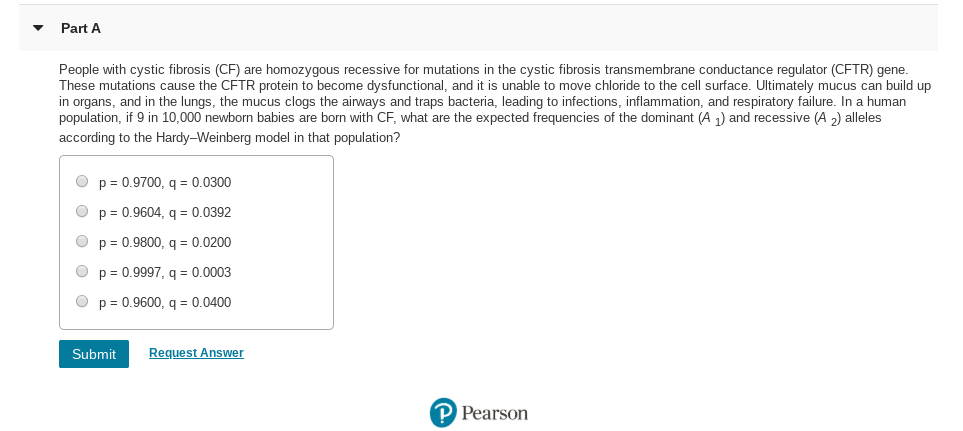Part A People with cystic fibrosis (CF) are homozygous recessive for mutations in the cystic fibrosis transmembrane conductance regulator (CFTR) gene. These mutations cause the CFTR protein to become dysfunctional, and it is unable to move chloride to the cell surface. Ultimately mucus can build up in organs, and in the lungs, the mucus clogs the airways and traps bacteria, leading to infections, inflammation, and respiratory failure. In a human population, if 9 in 10,000 newborn babies are born with CF, what are expected frequencies of the dominant (A 1) and recessive (A 2) alleles according to the Hardy-Weinberg model in that population? p = 0.9700, q = 0.0300 O p = 0.9604, q = 0.0392 p = 0.9800, q = 0.0200 p = 0.9997, q = 0.0003 O p= 0.9600, q = 0.0400 Request Answer Submit P Pearson
Part A People with cystic fibrosis (CF) are homozygous recessive for mutations in the cystic fibrosis transmembrane conductance regulator (CFTR) gene. These mutations cause the CFTR protein to become dysfunctional, and it is unable to move chloride to the cell surface. Ultimately mucus can build up in organs, and in the lungs, the mucus clogs the airways and traps bacteria, leading to infections, inflammation, and respiratory failure. In a human population, if 9 in 10,000 newborn babies are born with CF, what are expected frequencies of the dominant (A 1) and recessive (A 2) alleles according to the Hardy-Weinberg model in that population? p = 0.9700, q = 0.0300 O p = 0.9604, q = 0.0392 p = 0.9800, q = 0.0200 p = 0.9997, q = 0.0003 O p= 0.9600, q = 0.0400 Request Answer Submit P Pearson
Biology: The Dynamic Science (MindTap Course List)
4th Edition
ISBN:9781305389892
Author:Peter J. Russell, Paul E. Hertz, Beverly McMillan
Publisher:Peter J. Russell, Paul E. Hertz, Beverly McMillan
Chapter9: Cell Communication
Section: Chapter Questions
Problem 1ITD
Related questions
Question
100%
Please help me

Transcribed Image Text:Part A
People with cystic fibrosis (CF) are homozygous recessive for mutations in the cystic fibrosis transmembrane conductance regulator (CFTR) gene.
These mutations cause the CFTR protein to become dysfunctional, and it is unable to move chloride to the cell surface. Ultimately mucus can build up
in organs, and in the lungs, the mucus clogs the airways and traps bacteria, leading to infections, inflammation, and respiratory failure. In a human
population, if 9 in 10,000 newborn babies are born with CF, what are
expected frequencies of the dominant (A 1) and recessive (A 2) alleles
according to the Hardy-Weinberg model in that population?
p = 0.9700, q = 0.0300
O p = 0.9604, q = 0.0392
p = 0.9800, q = 0.0200
p = 0.9997, q = 0.0003
O p= 0.9600, q = 0.0400
Request Answer
Submit
P Pearson
Expert Solution
This question has been solved!
Explore an expertly crafted, step-by-step solution for a thorough understanding of key concepts.
This is a popular solution!
Trending now
This is a popular solution!
Step by step
Solved in 4 steps with 4 images

Knowledge Booster
Learn more about
Need a deep-dive on the concept behind this application? Look no further. Learn more about this topic, biology and related others by exploring similar questions and additional content below.Recommended textbooks for you

Biology: The Dynamic Science (MindTap Course List)
Biology
ISBN:
9781305389892
Author:
Peter J. Russell, Paul E. Hertz, Beverly McMillan
Publisher:
Cengage Learning

Human Heredity: Principles and Issues (MindTap Co…
Biology
ISBN:
9781305251052
Author:
Michael Cummings
Publisher:
Cengage Learning

Biology: The Dynamic Science (MindTap Course List)
Biology
ISBN:
9781305389892
Author:
Peter J. Russell, Paul E. Hertz, Beverly McMillan
Publisher:
Cengage Learning

Human Heredity: Principles and Issues (MindTap Co…
Biology
ISBN:
9781305251052
Author:
Michael Cummings
Publisher:
Cengage Learning